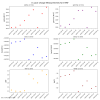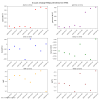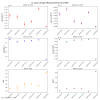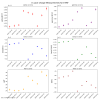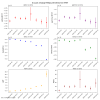artem.basalaev@LIGO.ORG - posted 02:32, Thursday 04 April 2024 (76923)
New python scripts to analyze In-Lock SUS Charge Measurements
Artem, Camilla, Louis, Oli Charge measurements analysis code (see InLock_Charge_Measurements wiki) has been translated from Matlab to python with following significant changes: * Channels H1:SUS-(QUAD)_L3_ESDAMON* are used, which are already calibrated to voltages and therefore don't require additional filters in the code; * At the same time channel H1:CAL-DELTAL_EXTERNAL_DQ does require calibration, which was not applied previously and now it is ("6-pole, 6-zeros transfer function"); * Transfer function "from m DARM to N force" was pulled from SUS model every time in Matlab code (dampjngfjlters_QUAD_2014-11-10_LLO_model.mat); now it is saved to static text file and loaded from there; * Uncertainties are added for all coefficients. Attached to this post is comparison of "old" and "new" analysis results. First thing that jumps out is that numbers are completely different. However this is not necessarily a bad thing. Here's a quote from Jeff: "I don't really have an intuitive map between the units of the in-lock charge measurement plots vs. well, anything. My instinct is to gravitate to what the calibration group creates - the unit-full numbers for the ESD actuation strength in units of (gamma-alpha) = [ N/V^2 ] (using the notation of Eq. 10 from [1]). That group thinks the latest best value for that number, as of May 10th 2023 was 2.545e-11 N/V^2 ( see the text table at the bottom page 11 of LHO:69696 ). And yet, the ETMX results from these in lock charge measurements report that the value is around (1650 - 4100) = -2.450e+3 [N/V^2]. Do we understand that 14 orders of magnitude discrepancy?" [1] LIGO-T1700446 With the new scripts the value I get for a measurement around that (May 9 2023) time is gamma-alpha = -2.973887691585383e-11. Besides this though, there are differences: * Signs appear to be flipped, currently I don't understand why. * Also some measurements (particularly for ITMX for some reason) have very low coherence in my calculations, I had to lover threshold from 0.25 used in Matlab code in order to process those. In principle, low coherence should be reflected in uncertainty, but I guess up to a point, for too low values this does not hold anymore. All scripts are available here: https://git.ligo.org/artem.basalaev/inlock_charge_measurements, hopefully accessible by everyone. Note that I can't update scripts in the control room anymore since I don't have remote access. The versions currently available there are buggy early versions of my scripts (but also old Matlab versions are still there). As of now, use gitlab link above instead if you want to try running them, also in the control room.
Images attached to this report

